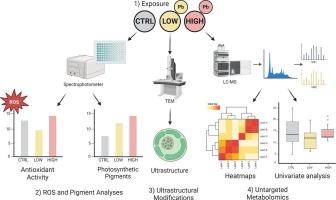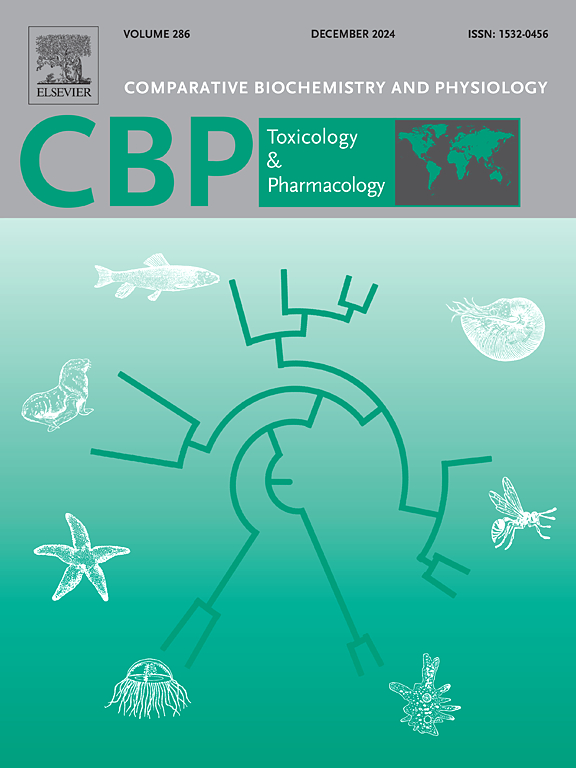铅对南极 Iridaea cordata(红藻纲)光合色素、抗氧化反应、代谢组学、叶片形态和细胞超微结构的影响。
IF 3.9
3区 环境科学与生态学
Q2 BIOCHEMISTRY & MOLECULAR BIOLOGY
Comparative Biochemistry and Physiology C-toxicology & Pharmacology
Pub Date : 2024-10-29
DOI:10.1016/j.cbpc.2024.110063
引用次数: 0
摘要
在过去的几十年里,由于铅即使在低浓度下也具有显著的毒性,人们对海洋环境中铅污染的关注与日俱增。铅是南极洲人类活动产生的重要污染物之一。然而,人们对其对极地光合生物的影响知之甚少。本研究旨在评估两种不同环境浓度的铅(10 μg/L 和 50 μg/L)对 Terra Nova 海湾(南极洲罗斯海)红藻 Iridaea cordata (Turner) Bory 的色素含量、抗氧化酶活性(过氧化氢酶、超氧化物歧化酶、抗坏血酸过氧化物酶和谷胱甘肽-S-转移酶)、代谢组、藻体形态和细胞超微结构的影响。结果表明,从 10 μg/L 开始,铅暴露会降低藻蓝蛋白和藻红蛋白的含量,而在 50 μg/L 时会诱导类胡萝卜素的积累。铅暴露后,过氧化氢酶、抗坏血酸过氧化物酶和超氧化物歧化酶的活性普遍升高,对照组和处理组的生化特征截然不同。铅对细胞超微结构的进一步影响包括花生淀粉积累和质体形成。总之,我们的研究结果表明,活性氧的形成对铅的反应增强,改变了灯心草的光合色素模式、抗氧化防御能力、代谢组和超微结构。本文章由计算机程序翻译,如有差异,请以英文原文为准。

Effect of lead on photosynthetic pigments, antioxidant responses, metabolomics, thalli morphology and cell ultrastructure of Iridaea cordata (Rhodophyta) from Antarctica
Over the past decades, the concern about lead pollution in marine environments has increased due to its remarkable toxicity, even at low concentrations. Lead is one of the significant contaminants arising from human activities in Antarctica. However, its effects on polar photosynthetic organisms are poorly known. This work aims to evaluate the effects of two different environmental concentrations of lead (10 μg/L and 50 μg/L) on pigment content, antioxidant enzyme activities (catalase, superoxide dismutase, ascorbate peroxidase and glutathione–S–transferase), metabolome, thalli morphology and cell ultrastructure of the red seaweed Iridaea cordata (Turner) Bory from Terra Nova Bay (Ross Sea, Antarctica). The results highlighted that lead exposure decreased phycocyanin and phycoerythrin content, starting from 10 μg/L, while induced carotenoid accumulation at 50 μg/L. Catalase, ascorbate peroxidase, and superoxide dismutase activities generally increased after lead exposure and distinct biochemical features were identified in the control and treatment groups. Further lead–related effects on cell ultrastructure comprised floridean starch accumulation and plastoglobuli formation. Overall, our results suggested that the enhanced formation of reactive oxygen species in response to lead altered the photosynthetic pigment pattern, antioxidant defenses, metabolome and ultrastructure of I. cordata.
求助全文
通过发布文献求助,成功后即可免费获取论文全文。
去求助
来源期刊
CiteScore
7.50
自引率
5.10%
发文量
206
审稿时长
30 days
期刊介绍:
Part C: Toxicology and Pharmacology. This journal is concerned with chemical and drug action at different levels of organization, biotransformation of xenobiotics, mechanisms of toxicity, including reactive oxygen species and carcinogenesis, endocrine disruptors, natural products chemistry, and signal transduction with a molecular approach to these fields.

 求助内容:
求助内容: 应助结果提醒方式:
应助结果提醒方式:


